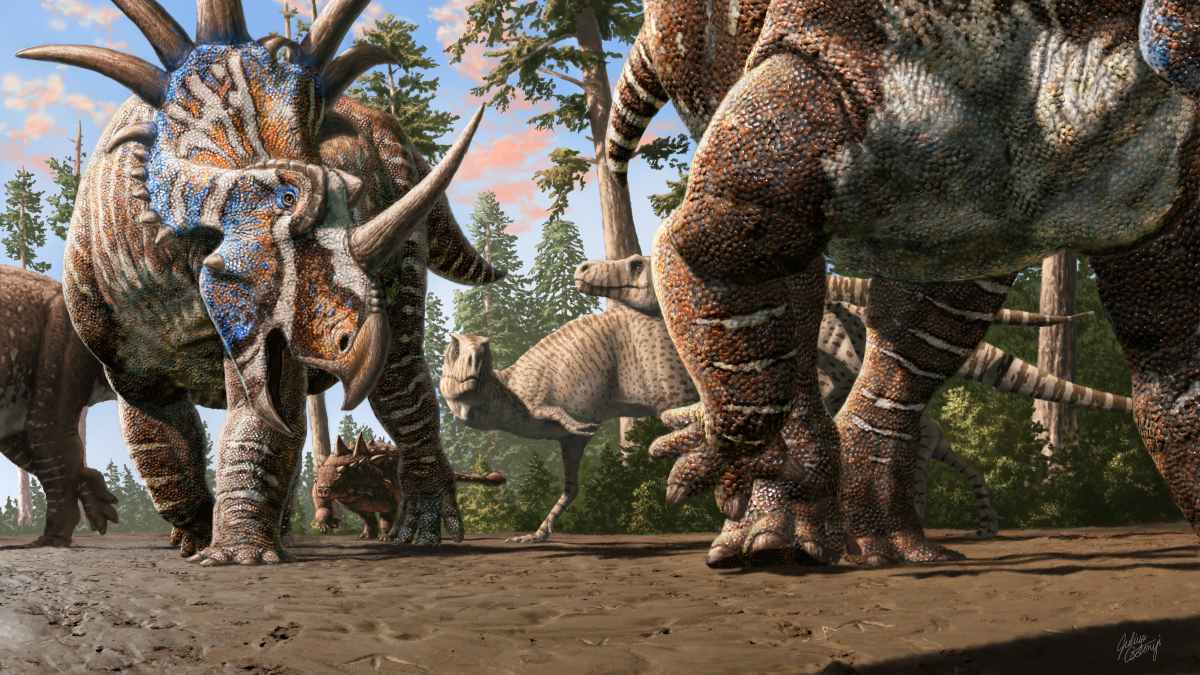
Fossil trackway in Canada is the first evidence that different dinosaur species herded together
How did your country report this? Share your view in the comments.
Diverging Reports Breakdown
Fossil trackway in Canada is the first evidence that different dinosaur species herded together
A unique fossil trackway in Canada provides a tantalising snapshot of an interaction between predatory dinosaurs and the herds of plant eaters which may have been their prey. At least 20 tracks left by dinosaurs 76 million years ago were uncovered in July 2024 at the Dinosaur Provincial Park in Canadian province Alberta. The tracks date to the latter part of the Cretaceous period which lasted until 66 mya when an asteroid ended the “Age of Dinosaurs” in a global mass extinction. The most unusual and scientifically significant discovery in the tracks is that the ceratopsians weren’t herding alone – they were joined by another plant eater belonging to the armoured ankylosaurid or nodosaurid groups. This is the first evidence of a mixed herd of different dinosaur species. Mixed herding is seen in modern animals today, for example zebra and wildebeest are often seen in mixed herds on Africa’s plains.
A unique fossil trackway in Canada provides a tantalising snapshot of an interaction between predatory dinosaurs and the herds of plant eaters which may have been their prey.
At least 20 tracks left by dinosaurs 76 million years ago (mya) were uncovered in July 2024 at the Dinosaur Provincial Park in Canadian province Alberta. The tracks date to the latter part of the Cretaceous period which lasted until 66 mya when an asteroid ended the “Age of Dinosaurs” in a global mass extinction.
Palaeontologists excavated about 29m2 of the site to reveal 13 footprints left by ceratopsian dinosaurs – horned plant eaters related to Triceratops. These tracks were left by at least 5 individuals walking side-by-side, indicating a herd.
Digital Elevation Model of Skyline tracksite (elevation scale in m) and key tracks (scaled to relative elevation). Credit: Dr Brian Pickles, University of Reading.
The team identify 2 ceratopsian genera known from the region which fit the tracks’ size, shape and age: Styracosaurus (grew to 5.5m long, 3 tonnes) or Chasmosaurus (5m long, 2 tonnes).
Aother 3 tracks belong to a meat-eating dinosaur from the same group as Tyrannosaurus rex, but smaller.
The tyrannosaurid tracks could have been left by a small predator stalking its prey.
But the most unusual and scientifically significant discovery in the tracks is that the ceratopsians weren’t herding alone – they were joined by another plant eater belonging to the armoured ankylosaurid or nodosaurid groups.
Several candidate species have been suggested for these tracks, including the 7m-long, 2-tonnes ankylosaurids Euoplocephalus and Dyoplosaurus, or the similar-sized Panoplosaurus.
This is the first evidence of a mixed herd of different dinosaur species. Mixed herding is seen in modern animals today, for example zebra and wildebeest are often seen in mixed herds on Africa’s plains.
Palaeontologists have often wondered if dinosaurs might also have exhibited this behaviour as a means of mutual protection.
This theory was presented in the 1999 BBC documentary series Walking With Dinosaurs but the Canadian tracks are the first time that concrete fossil evidence has shown different species of dinosaur herding together.
The find is detailed in a paper published in PLOS One.
“I’ve collected dinosaur bones in Dinosaur Provincial Park for nearly 20 years, but I’d never given footprints much thought,” says co-lead author Phil Bell from Australia’s University of New England. “This rim of rock had the look of mud that had been squelched out between your toes, and I was immediately intrigued.”
“The tyrannosaur tracks give the sense that they were really eyeing up the herd, which is a pretty chilling thought, but we don’t know for certain whether they actually crossed paths.”
“It was incredibly exciting to be walking in the footsteps of dinosaurs 76 million years after they laid them down,” adds co-lead author Brian Pickles from the University of Reading, UK. “Using the new search images for these footprints, we have been able to discover several more track sites within the varied terrain of the Park, which I am sure will tell us even more about how these fascinating creatures interacted with each other and behaved in their natural environment.”
RTMP technician working on Skyline tracksite. Credit: Dr Brian Pickles, University of Reading.
“This discovery shows just how much there is still to uncover in dinosaur palaeontology,” says senior author Caleb Brown from Canada’s Royal Tyrrell Museum of Palaeontology. “Dinosaur Park is one of the best understood dinosaur assemblages globally, with more than a century of intense collection and study, but it is only now that we are getting a sense for its full potential for dinosaur trackways.”
Source: https://cosmosmagazine.com/history/palaeontology/fossil-trackway-canada-mixed-herd-dinosaur/
